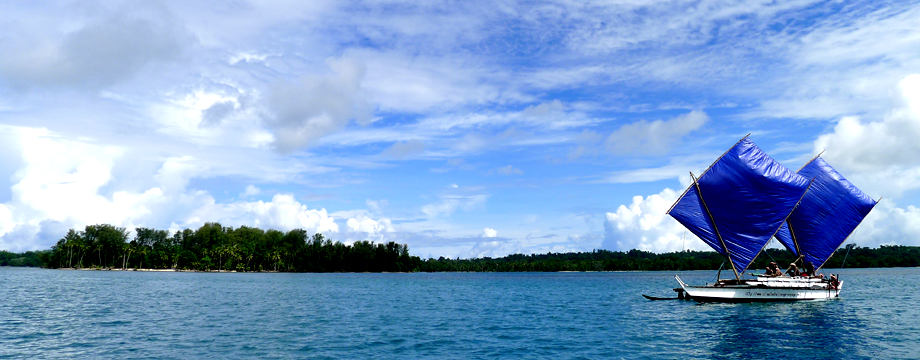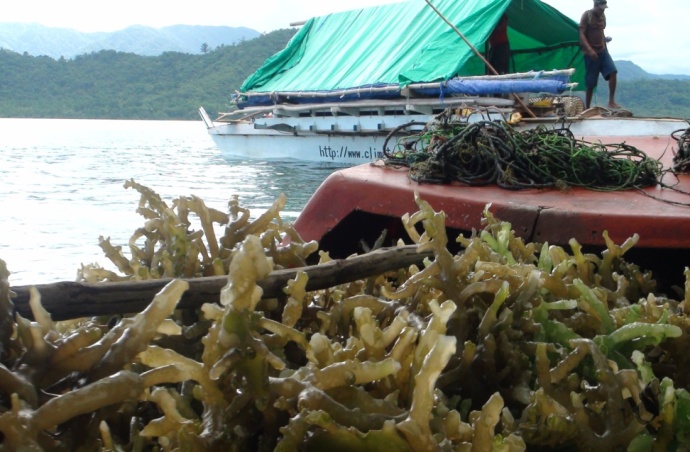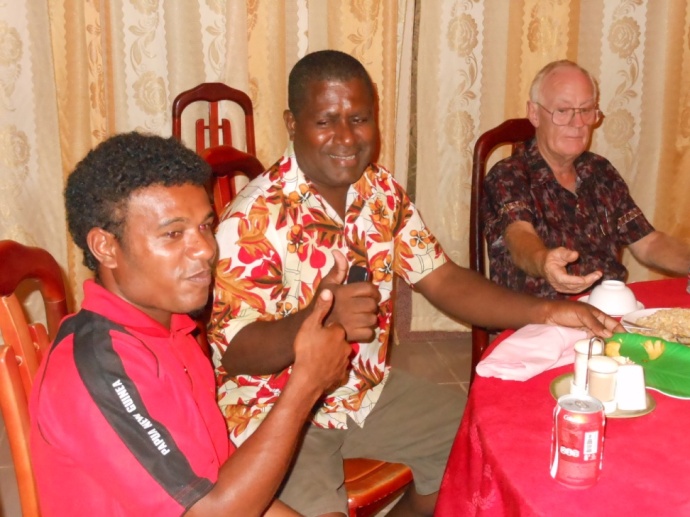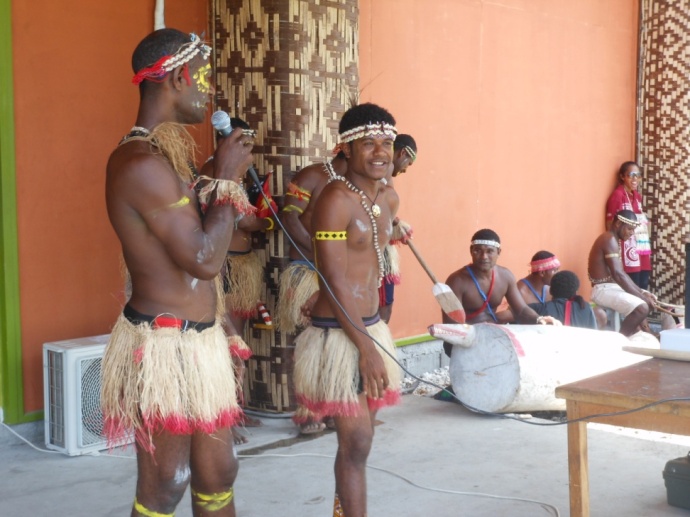This is the first official video (10.30min) of the Climate Challenger Voyage, and it is ready to watch online now! We will also be entering it into the Rare and The Nature Conservancy’s sponsored Solution Search competition. Please show your support by voting for us on the Solution Search website. We hope you all enjoy reliving our journey!
Author Archives: climatechallengercrew
The First Official Climate Challenger Voyage Film HD 10.30mins
Tears of Joy as Climate Challenger Returns Home
AFTER A THREE MONTH epic canoe voyage, Climate Challenger has finally returned home.
It was around 8am 5th of December, making a steady 10 knots with our sails well set, that we returned to Pere, our home, after a sometimes hazardous voyage that had taken us from Manus to the Solomon Islands and back to PNG again, hurrying north just ahead of the cyclone season.
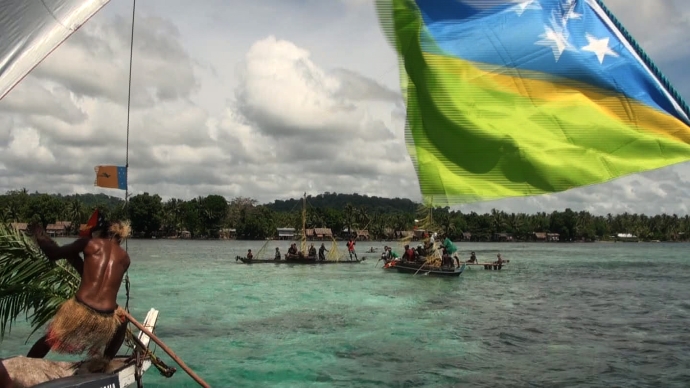
Climate Challenger flying the Solomon Island flag, cruises into Pere village after their 3 month long distance voyage. (photo: taken as a still from video)
On Pere we could see a crowd of waiting friends, families and loved ones who had flocked to the shore. Echoes of the steady rhythm of the garamut filtered to our ears as we sailed in through the reef. Nearby, four canoes decorated with sago palms waited to escort us to the beach front. They were the proud seafaring canoes performing a guard of honor. We, the crew of Climate Challenger, were also dressed in our traditional attire and danced to the beat of the garamut as we sailed in. I kept my video camera rolling, filming every action, it will be a big celebration, I thought to myself.
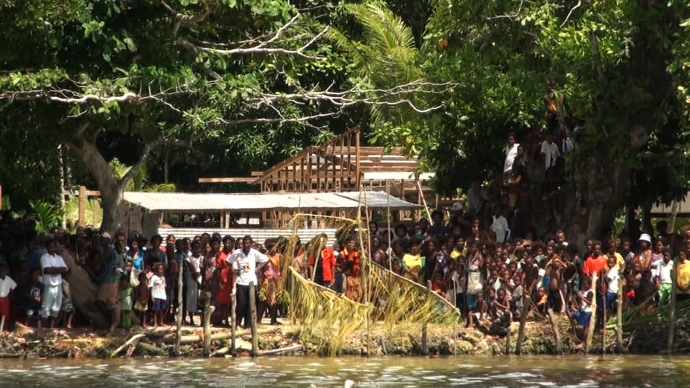
Villagers of Pere village wait on shore for the Climate Challenger and crew. (photo: still from video)
The garamut rocked Pere as traditional dancers danced in to meet us as the guard of honour escorted us ashore. The flower girls put wreaths around our neck and we proceeded to meet the village chiefs, councillors and church elders who had lined up to receive us. In every corner we could hear people shouting and cheering. Everyone was so proud and happy to see us back safe and sound. The crew members were rounded up by their immediate families – shaking hands, chatting, crying. I could see tears of joy everywhere. It was a proud moment of my life and indeed a relief to be on Pere, finally home and reunited with our families.
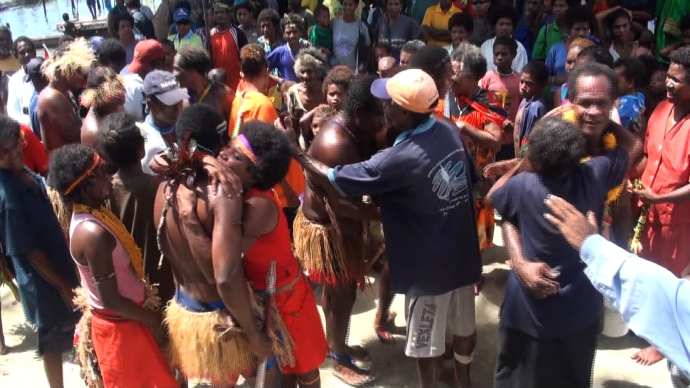
Pere villagers happy to see the Climate Challenger crew return home safely. (photo: still taken from video)
The challenges, the sleepless nights and stressful times were over but the voyage is not. There is far to go in making our Pacific an environmentally secure place.
Climate Challenger Voyage Documentary
I am in Brisbane Australia now working on editing all of our video footage with film maker, Kat Gawlik. We expect to complete the documentary about the voyage by early April, 2013.
Climate Challenger will commence its journey early next year once funding is secured. This year, the crews planned to build a bigger canoe where it will join Climate Challenger on the next epic voyage where the crews planned to sail from Manus to Palau then to Marshall Islands. Open Member for Manus Hon. Ronny Knight has already pledged his support to build the new canoe.
Thank you all for joining us and we hope to update you all soon on the progress of our preparation and what is forthcoming in regards to our fundraising and our Pacific voyage.
Captain Manuai Matawai
Cyclone Season = Change of Plans
Hello all following our voyage,
I just wanted to let you all know that there has been a change of plans for our voyage. Instead of heading to Nauru and continuing on to the Marshall Islands and Micronesia, the Climate Challenger will be heading back to Manus Island, Papua New Guinea to continue the voyage next year. Because the trip has taken longer than anticipated, we are now heading into cyclone season in the Pacific and would be attempting to cross the largest stretches of ocean so far in the voyage which is just too risky.
Initially we planned to stop at villages for short periods only but more villages especially in the Solomon Islands are showing interest in the voyage and requesting the crew visit to share their experiences and knowledge in conservation and climate change.
Naro, West Guadalcanal
After leaving Marau where we saw their seaweed farming and screen printed our new sails, we visited the village of Naro, west Guadalcanal, who has set up a locally managed marine area (LMMA), or tambu area, to conserve their marine resources and increase their food security. More than 100 men, women and children came to listen to our experiences in conservation and climate change adaptation.

Bernard Checheng Manus shares Mbuke experience in community climate change adaptation initiatives with Naro Community. 7/11/12
Honiara Clean Up
We returned to Honiara, Solomon Islands yesterday to participate in the Clean Pacific Campaign and clean up the rubbish and plastics from the beachfront outside the Mendana Hotel. We will continue to remove rubbish from the shores around Honiara until we set sail for Savo Island at the end of the week.

Bernard Checheng Manus leads the clean up on Mendana Hotel beach front – photo by Manuai Matawai – 8/11/12
Although we will be missing Micronesia this time, we will be seeing you next year. This will also give us more time to raise needed funds, produce our documentary and plan the next phase of our journey. We’ll keep you posted on our revised plans as they arise. Thanks for your continuing support!
Capt. Manuai Matawai
Seaweed Farming on Simeruka Island
From Honiara, we traveled to Marau on the eastern tip of Guadalcanal, and were accompanied by John Houakau a village development worker with FSPI (Foundation of the People of South Pacific International) who is also from Marau. John and I met in Fiji in 2009, when we both attended a Marine Management Course at University of South Pacific.
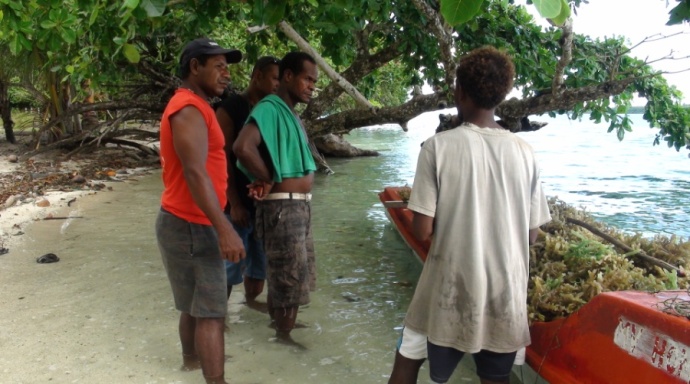
Fred Toitoro, farmer and local marketing agent on Simeruka Island briefs the Climate Challenger crew on the seaweed project on Marau as an alternate livelihood project for economic security – photo by Manuai Matawai
Marau people are dependent on marine resources for economic security and thus realized that their marine resources were depleting and therefore needed to set aside locally managed marine areas (LMMA ). However, the people of Marau need to earn money. Seaweed farming was introduced to the people of Marau by FSPI in 2009. Seaweed was identified as an alternate income generating source to support livelihood. With help of FSPI, the seaweed (Kappaphceus alvarnzii) was imported from Philippines 3 years ago. The seaweed is fetching SD3.00/kg in Honiara by some Asians namely Lee Kok Kuen. Seaweed is used in pharmaceuticals, as a preservative and food additive.
The Benefits of Farming Seaweed
When asked about the benefits, economically, it support family’s livelihood and eases the family’s burden on school fees and basic household needs. Environmentally, when fishing pressure is taken out, tambu reefs are recovering as more fish come in abundance and coral health cover is improving compared to before. Socially, seaweed farming is a family oriented business where all fully participate, and it eases social problems such as unemployment.
Although seaweed farming brings many benefits, transport costs are an issue with the community which is very much killing their effort.

Patrick Haukare (Fisheries Officer) on Marau interviewed by Benedick Tova (Provincial Lands Officer) – photo by Manuai Matawai
The Process
A healthy young seaweed branch is cut out from the mature weed and tied onto a 30m string rope. Space between each seedling is about 20 to 25 cm. The string of young seaweed is tied onto a young round mangrove pole stretching horizontally in the water where there is a slight current. The seaweed is submerged in the water and should reach maturity after 6 weeks. The seaweed is harvested and dried in the sun. An average drying time is 4 days if there is plenty of sunshine.
Crew members Pokakes Pondraken of Pere and Bernard Checheng of Mbuke suggested that this is a good alternative livelihood project to bring economic security, and would like to introduce in Manus.
We arrived back in Honiara on Tuesday and will be heading to Naro today then to Savo Island before departing for Western Province (New Georgia) by the end of the week.
Capt. Manuai Matawai
Ysabel Province, Solomon Islands
Our trip through the Solomon Islands so far has gone well with great coordination by The Nature Conservancy’s ground coordinating team- John Pita on Ysabel and TNC staff in Honiara. The communities of Kia and Buala hosted us with great hospitality. We did our usual culture, conservation and climate change awareness presentations which were really well received and appreciated by both the people and community leaders of Kia and Buala. In Kia the crew were able to meet the famous Rence Zama, ‘Home For Hawksbill’ movie star, and video interview some locals on climate change issues.

Climate Challenger crew pose with Rence Zama, ‘Home For Hawksbill’ film star at Kia. Photo: Manuai Matawai
The group also met Richard Hamilton and Glen Almany, marine scientists on Kia doing research on the hump head parrot fish. It has been a great experience for the crew to see new places for the first time. It has been a memorable journey so far that will never be forgotten.

The Climate Challenger departs Kia for Buala with Richard Hamilton on board. Photo by Manuai Matawai
On Buala, the crew were able to do a demo site for a dry stone wall next to Ivan Rotu’s place. We also left a copy of the dry stone wall video with Rotu for anyone interested. More than 50 people came to observe the walling demonstration. Manoi Ponowan also met with two people suffering from cancer and kidney stones. Manoi wasted no time looking around the forest searching for herbal medicine to treat the two patients.
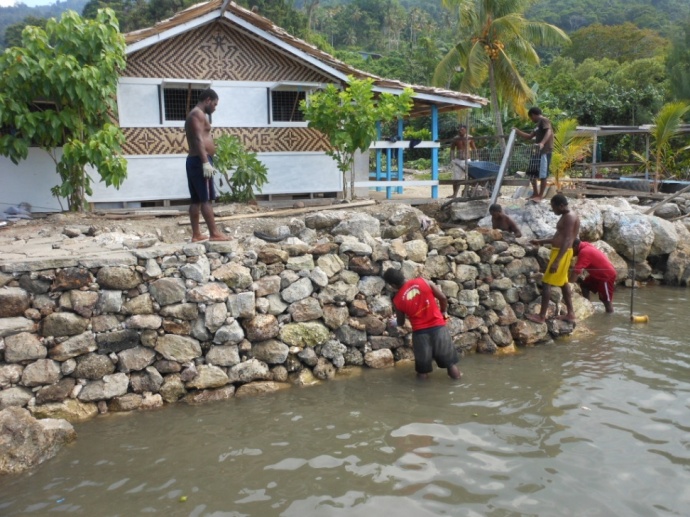
Climate Challenger crew build a 7 metre long dry stone wall on Buala as demonstration site for coastal protection. Photo by Manuai Matawai
We left Buala on Sunday afternoon around 5 pm crossing over the western tip of Ysabel. The weather was quite rough with thunderstorms but the moon gave us plenty of light to find our way. We arrived in Honiara around 3 pm. Willie Atu from The Nature Conservancy and the media team met us on the way and escorted us to the Honiara Yacht Club. The crew joined other TNC partners here in Honiara for the welcome reception dinner at the Sea King Restaurant. Yesterday, the team performed a cultural dance at the Honiara National Museum and will do more presentations this week including one for the Australian High Commissioner this Thursday night.
Manuai
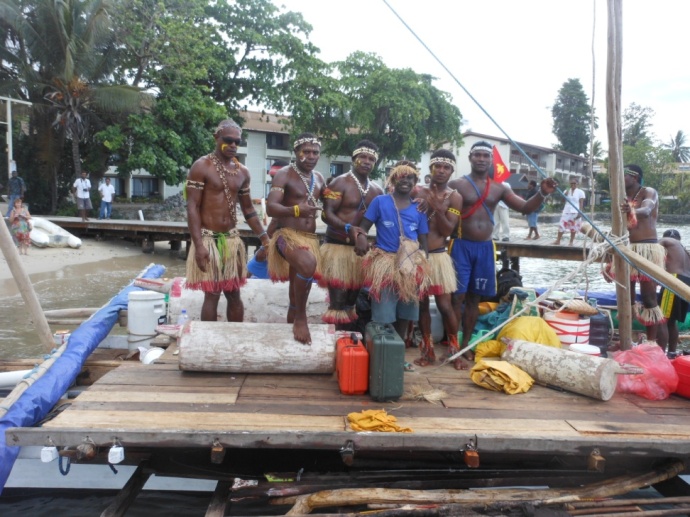
Climate Challenger arrives at Honiara and crew pose with friend Jimmy Atu, son of Willie Atu – photo by Manuai Matawai
Radio Australia Interviews Climate Challenger Skipper
 The Climate Challenger arrived in Honiara the Solomon Islands today and we are looking forward tonight to a welcoming reception from the PNG High Commission, Australian and Solomon Islands government and media.
The Climate Challenger arrived in Honiara the Solomon Islands today and we are looking forward tonight to a welcoming reception from the PNG High Commission, Australian and Solomon Islands government and media.
It is expected that we will depart Honiara for Nauru on Friday.
Here is a radio interview Manuai did for the Tok Pisin show from Radio Australia.
Turtle Conservation at Arnavon Islands

Moses and the Climate Challenger crew with juvenile turtles ready to begin their journey in the sea of the unexpected. Photo: Arnavon islands, by Manuai Matawai.
After leaving Taro, we stopped in at Wagina yesterday where a large community of Kiribati people now call home after being relocated here by the British last century.
The Climate Challenger and crew are now at the Arnavon Islands, Solomon Islands, known as the ‘home of the hawksbill turtle’. Moses Pema, a conservation officer at the Arnavons, took time to brief the boys on the turtle project and some of the activities carried out on the island. The crew went for a site visit around the turtle nesting places and witnessed young turtle hatchlings ready to find their way to the sea. Bernard Checheng Manus when interviewed about his short visit here said, ‘I have learnt a lot. I have seen the movie Home for Hawksbill, but now I have witnessed it myself. I will get back to my island and look after the turtle nesting places”.

Conservation officer Moses Pema, educates the Climate Challenger crew on the turtle nursery project at Arnavon Islands, known as ‘home of the hawksbill turtle’ – photo by Manuai Matawai 15/10/12
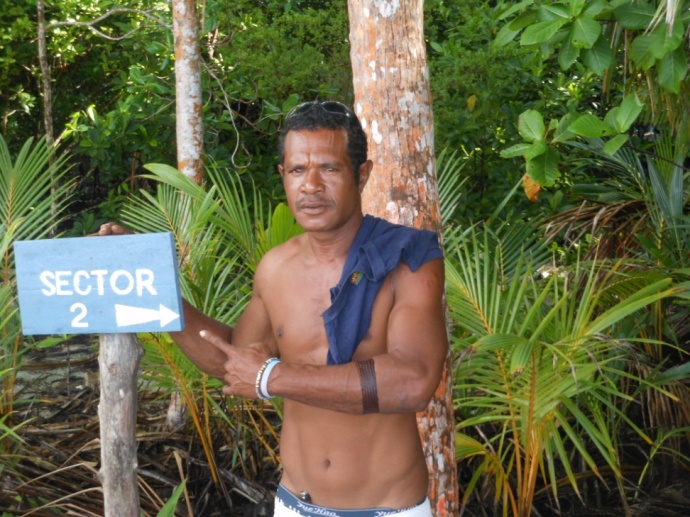
Bernard Checheng Manus said, “I have seen the movie ‘Home For Hawksbill’, now I have set foot here and witnessed what this place has to offer. I hope to go back home and look after our turtle nesting areas on Mbuke and the surrounding islands. Pix by Manuai Matawai
I visited here in 2008 and after 4 years, I have seen a few changes; a new building erected, wireless satellite internet connection and solar lighting installed. But the sad news is that, the shore line is eroding as a result of rising sea level which will have an impact on the nursery areas for the turtle. We may lose this beautiful place on earth.
We expect to depart the Arnavon’s at 12 pm today for Kia where we will be doing awareness; connecting culture, conservation and climate change.
Manuai
Climate Change Adaptation in Action on Mbuke and Whal Islands [HD VIDEO]

Crew member of the Climate Challenger, Bernard Manus, joined the voyage to share knowledge and experiences of climate change adaptation from his home, Mbuke Island, Manus Province, PNG
One of our crew members, Bernard Manus, comes from Mbuke Island, a small volcanic island off the southern coast of Manus Island. With the help of the locally formed committee – the Mbuke Island’s Peoples Association (MIPA), and support from environmental NGO’s and the PNG government, they have initiated a series of projects that are helping the people adapt to the impacts of climate change and increase their resilience and food security in these changing times.

Mbuke Island, is a small volcanic island rising from the sea (right), and the people rely heavily on the bounty from the sea. photo: Kat Gawlik
The following 9 minute video, filmed by Climate Challenger Skipper, Manuai Matawai, looks into the various climate change adaptation and conservation projects on Mbuke and Whal Islands. This includes mangrove planting, growing yams; a resilient and versatile food crop, and setting up locally-managed marine areas to allow fish populations to breed. Throughout the Climate Challenger voyage, the crew screen this documentary in the various villages they stop in along the way, as part of their ‘awareness show’.
Farewell Taro

Climate Challenger back in the water with additional features ready to commence sailing. Pix by Manuai Matawai – 11/10/12
Our last day in Taro, Choiseul Island (Solomon Islands) was a busy day for us, making use of every hour to catch up with canoe work and spreading awareness on climate change before we departed for Wagina. We had a wonderful reception on Taro. Our deepest gratitude goes to Jimmy Kereseka and his family for taking care of our logistics and looking after the crew for almost a week here on Supizae Island. Also thank you to the Premier of Choiseul Province and friends for their support and hospitality.

Climate Challenger skipper Manuai Matawai presenting awareness on climate change and canoe voyage to students of Choiseul Bay Secondary School – photo by Jimmy Kereseka. 10/11/12

Climate Challenger crew – from left to right – Manoi Ponowan, Pokakes Pondraken and Pakop Samol relaxing after garamut dance at Choiseul Bay Secondary School in Choiseul Province. Photo: Jimmy Kereseka -10/10/12
During our time on Supizae Island, we did three awareness shows; Taro, PoroPoro village and the last night at Choiseul Bay Secondary School. It was a ‘Manus Way’ style show- garamut drum dancing, a brief on our canoe voyage including the objectives, then followed by climate change awareness answering questions such as “what is climate change?”, “how is it caused?”, and “what are the impacts and what can we do about it?”. Bernard Manus from Mbuke Island presented a case study of his island followed by playing the Mbuke/Whal climate change video documentary.
It was great to have Robyn James, the project manager of The Nature Conservancy’s Climate Change Adaptation project present with us and to witness and support our performance on Taro and last night at the school. Robyn commented that “climate change is thought about in Australia where I am from, but the concept of linking culture, conservation and climate change is exciting and much more interesting than learning from a book. I hope that your crew can one day come to Australia to share your culture and lessons about climate change with people there”.

Pokakes Pondraken doing final touches on Climate Challenger before going into the water – photo by Manuai Matawai – 11/10/2012
We have updated the itinerary for while we are here in the Solomon Islands:
Proposed Itinerary
ETA = Estimated time of arrival
ETD = Estimated time of departure
Friday 12/10/12
ETD Taro at 9.00 am for Nukiki village (4 miles from Supizae, the team will present awareness on Climate change/Manus dance etc).
ETD Nukiki at 4 pm for Wagina.
Saturday 13/10/12
ETA Wagina 6 am (awareness connecting culture, conservation, climate change).
Sunday 14/10/12
ETD Wagina at 1 pm for Arnavons.
ETA Arnavon Islands at 4pm (free time, team will visit management site).
Monday 15/10/12
ETD Arnavon Islands at 8 am for Kia.
ETA Kia at 12 pm (awareness connecting culture, conservation and climate change).
Tuesday 16/10/12
ETD Kia at 7 am for Buala.
ETA Buala 8 pm (awareness connecting culture, conservation and climate change).
Wednesday 17/10/12
ETD Buala at 8 am for Honiara. Might do awareness on the way.
Thursday 18/10/12
Arrive Honiara, time dependent on weather conditions.
Maintenance on Supizae Island
We are on Supizae Island working on the canoe but also took some time out fishing to support our daily meals. Last Friday, we caught some yellow fin tuna, skip jack and rainbow runner. We cut some into steak and cooked on barbecue. The rest of the fish were smoked. On Saturday, we had to rip timbers for the canoe. The work on canoe will be completed by tomorrow ready to set sail on Thursday to Isabel Province then to Honiara. While in Choiseul, we will be conducting a dry stone wall workshop and do more awareness on climate change and sea level rise. The PNG, Manus Community and the PNG High Commissioner are desperately looking forward to meeting us in Honiara. They will be staging a big welcome for us. We expect to arrive at Honiara by Friday next week. But on the way through, we will be making a stop over on Wagina and Kia in Isabel conducting awareness. Willie Atu from The Nature Conservancy, Honiara is expected to join the crew on climate challenger on Isabel province and sail to Honiara.
